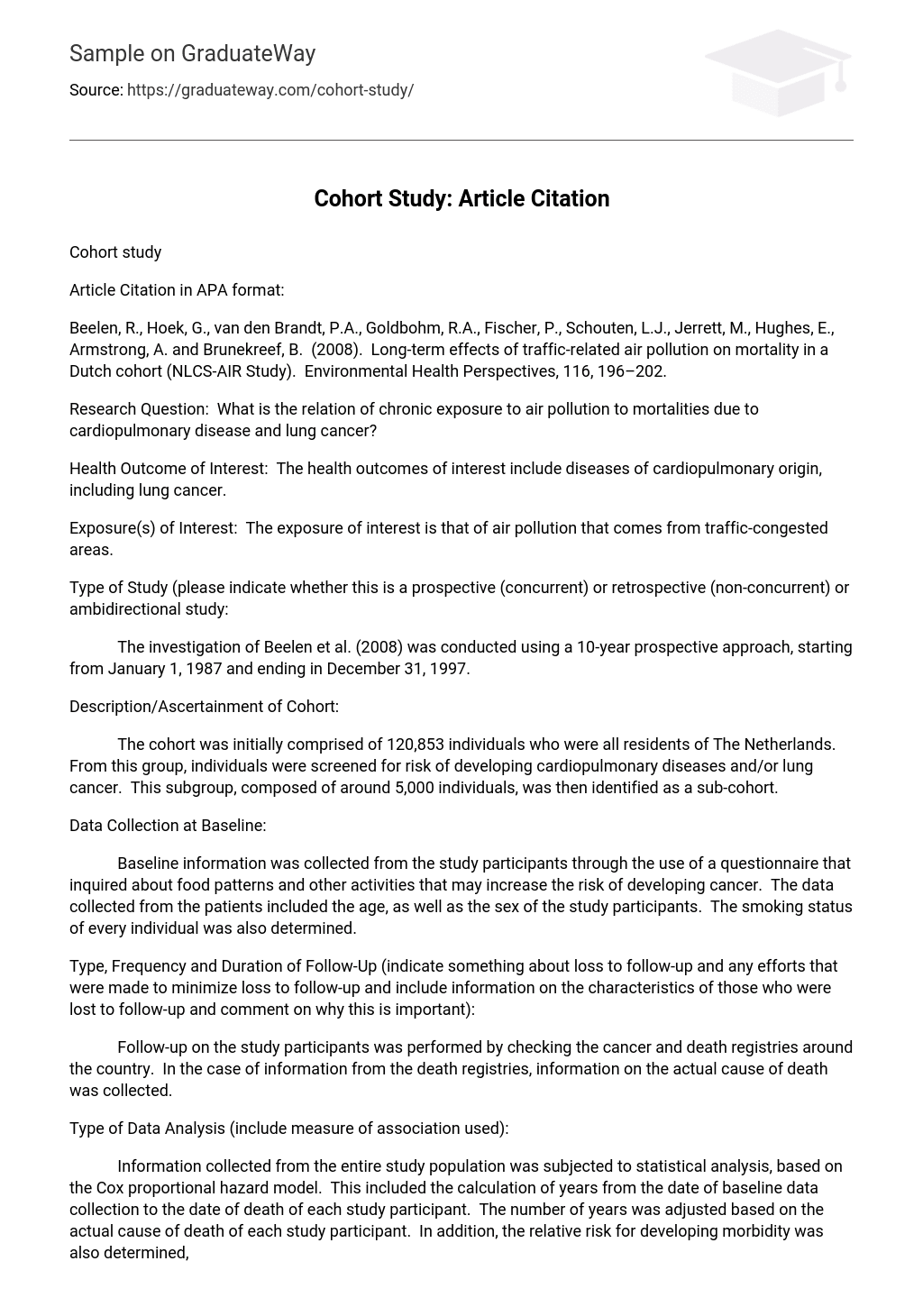Cohort study
Article Citation in APA format:
Beelen, R., Hoek, G., van den Brandt, P.A., Goldbohm, R.A., Fischer, P., Schouten, L.J., Jerrett, M., Hughes, E., Armstrong, A. and Brunekreef, B. (2008). Long-term effects of traffic-related air pollution on mortality in a Dutch cohort (NLCS-AIR Study). Environmental Health Perspectives, 116, 196–202.
Research Question: What is the relation of chronic exposure to air pollution to mortalities due to cardiopulmonary disease and lung cancer?
Health Outcome of Interest: The health outcomes of interest include diseases of cardiopulmonary origin, including lung cancer.
Exposure(s) of Interest: The exposure of interest is that of air pollution that comes from traffic-congested areas.
Type of Study (please indicate whether this is a prospective (concurrent) or retrospective (non-concurrent) or ambidirectional study:
The investigation of Beelen et al. (2008) was conducted using a 10-year prospective approach, starting from January 1, 1987 and ending in December 31, 1997.
Description/Ascertainment of Cohort:
The cohort was initially comprised of 120,853 individuals who were all residents of The Netherlands. From this group, individuals were screened for risk of developing cardiopulmonary diseases and/or lung cancer. This subgroup, composed of around 5,000 individuals, was then identified as a sub-cohort.
Data Collection at Baseline:
Baseline information was collected from the study participants through the use of a questionnaire that inquired about food patterns and other activities that may increase the risk of developing cancer. The data collected from the patients included the age, as well as the sex of the study participants. The smoking status of every individual was also determined.
Type, Frequency and Duration of Follow-Up (indicate something about loss to follow-up and any efforts that were made to minimize loss to follow-up and include information on the characteristics of those who were lost to follow-up and comment on why this is important):
Follow-up on the study participants was performed by checking the cancer and death registries around the country. In the case of information from the death registries, information on the actual cause of death was collected.
Type of Data Analysis (include measure of association used):
Information collected from the entire study population was subjected to statistical analysis, based on the Cox proportional hazard model. This included the calculation of years from the date of baseline data collection to the date of death of each study participant. The number of years was adjusted based on the actual cause of death of each study participant. In addition, the relative risk for developing morbidity was also determined, based on the concentration of each pollutant in the air. For example, the relative risk of morbidity was computed based on the amount of nitrogen dioxide (NO2) in the atmosphere.
Results/Main Findings of Study:
The research article reported that approximately 15% of the study population died during the investigation. Moreover, an associated was established between the amount and exposure of the study participants to NO2 and mortality due to respiratory diseases. The same association was observed with black smoke, but not with sulfur dioxide (SO2). The rate of mortality based on the air pollution was similar in both sexes and no gender-specific patterns could be identified. Interestingly, there was also a significant association between cardiopulmonary mortality caused by air pollution and the socioeconomic status of the study participants. The study showed that individuals in the lower income bracket had a higher incidence of mortality than those in the higher income bracket.
Assessment of Bias (selection and information):
The investigators indicated that there may be some form of bias in their study, especially on the issue of socioeconomic status. The report indicated that there were study participants that left the study during the 10-year monitoring period as they relocated to another country. The usual reason behind such migration is that the study participants were financially capable of leaving the country to find better areas to live in. In addition, individuals from the higher income bracket have easier access and more choice with regards to food items, including more fruits and vegetables for their daily diet. This capacity may decrease the chances of an individual to develop cancer and other cardiopulmonary conditions.
Assessment of Confounders:
The quality of air within the home may pose as a confounding factor that was not analyzed by the investigators. The study concentrated on the outside air pollution, while there was no analysis of the quality of air in the homes of these study participants. It may thus be possible that some of the mortalities were actually caused by the poor quality of air within their homes, or possibly the occurrence of smoking inside the house (Pope et al., 2002). The quality and condition of the homes, such as the presence of asbestos in the walls, may also influence the frequency of cardiopulmonary and cancer cases in the study population.
Comments:
The study provided a comprehensive assessment of the link between air pollution and the incidence of cardiopulmonary diseases and lung cancer in The Netherlands. Although there have been previous studies on this in the same country, this research report provided a more detailed description of the association, as well as provided a bigger study population (Beelen et al., 2007). The report thus serves as a validation of previous reports on a larger scale.
References
Beelen, R., Hoek, G., van den Brandt, P.A., Goldbohm, R.A., Fischer, P., Schouten, L.J., Jerrett, M., Hughes, E., Armstrong, A. and Brunekreef, B. (2008). Long-term effects of traffic-related air pollution on mortality in a Dutch cohort (NLCS-AIR Study). Environmental Health Perspectives, 116, 196–202.
Beelen, R., Hoek, G., Fischer, P., van den Brandt, P.A. and Brunekreef, B. (2007). Estimated long-term outdoor air pollution concentrations in a cohort study. Atmosphere and Environment, 41, 1343–1358.
Pope, C.A. III, Burnett, R.T., Thun, M.J., Calle, E.E., Krewski, D. and Ito, K. (2002). Lung cancer, cardiopulmonary mortality, and long-term exposure to fine particulate air pollution. JAMA, 287, 1132–1141.





